Charles Sturt University HRM514 Report: Cross-Cultural HR Practices
VerifiedAdded on 2022/09/16
|14
|3266
|27
Report
AI Summary
This report, prepared for HRM514 at Charles Sturt University, examines the non-transferability of HR practices across cultures, focusing on performance appraisal and training and development. It critically evaluates how cultural differences, particularly those highlighted by Hofstede's model, impact the implementation of these practices in international contexts. The report explores similarities and differences in HR functions between Eastern and Western countries, providing a comprehensive analysis of the challenges and considerations for international human resource management. It also includes recommendations for effective HR strategies in a globalized environment, emphasizing communication, relationship building, embracing diversity and knowledge transfer. The report highlights the importance of adapting HR practices to local cultural norms to maximize productivity and success, and concludes by emphasizing the role of HR professionals in aligning strategies with organizational goals. This report is a valuable resource for students studying international human resource management.
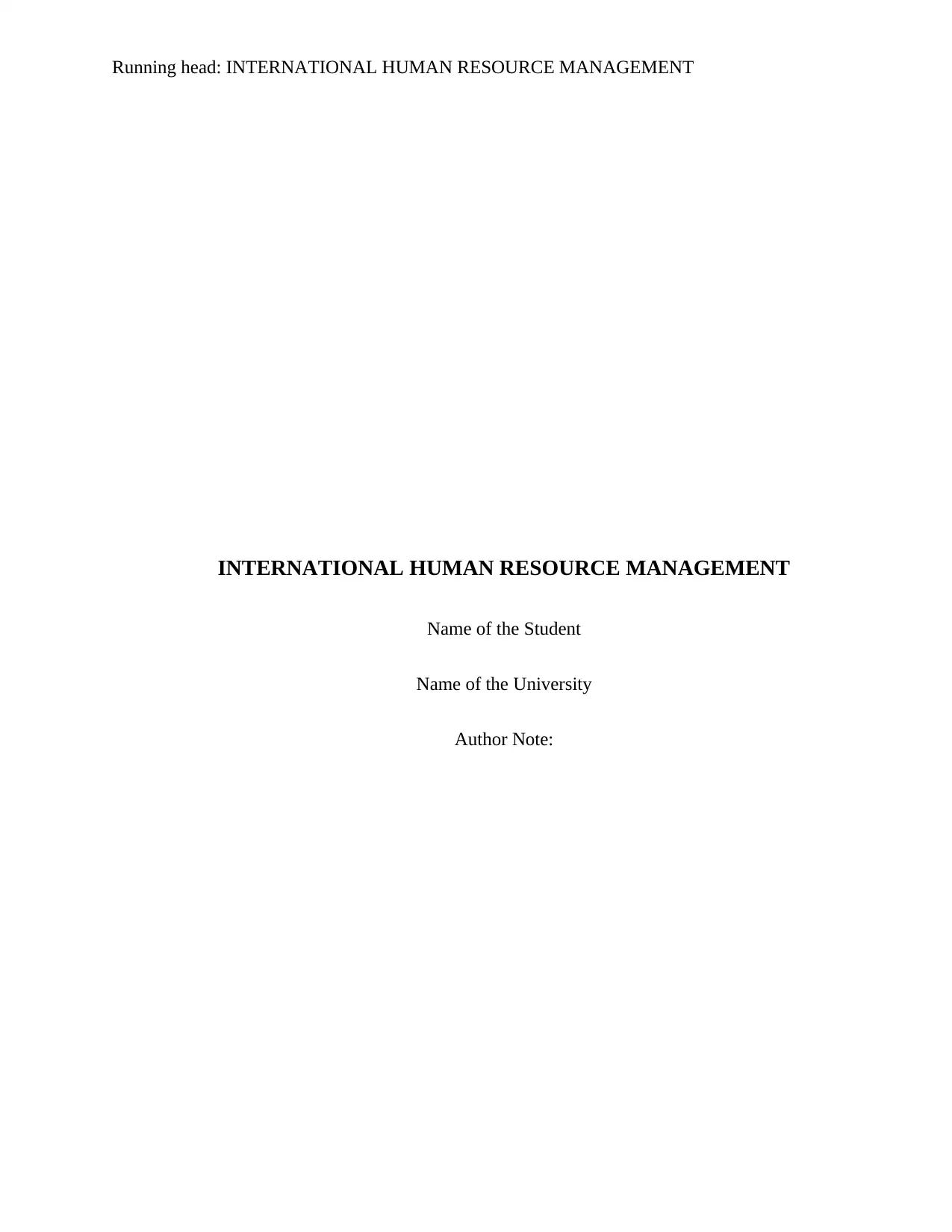
Running head: INTERNATIONAL HUMAN RESOURCE MANAGEMENT
INTERNATIONAL HUMAN RESOURCE MANAGEMENT
Name of the Student
Name of the University
Author Note:
INTERNATIONAL HUMAN RESOURCE MANAGEMENT
Name of the Student
Name of the University
Author Note:
Paraphrase This Document
Need a fresh take? Get an instant paraphrase of this document with our AI Paraphraser
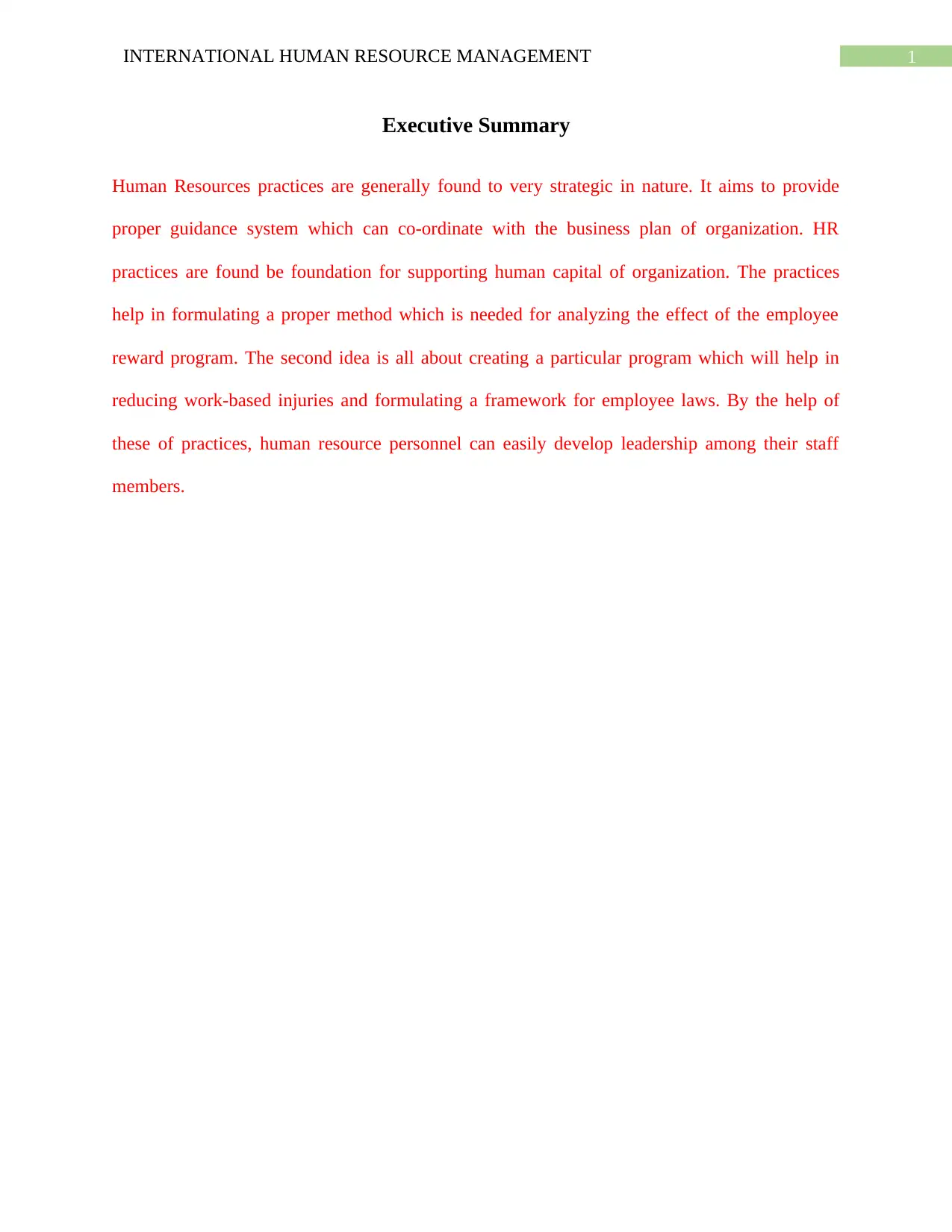
1INTERNATIONAL HUMAN RESOURCE MANAGEMENT
Executive Summary
Human Resources practices are generally found to very strategic in nature. It aims to provide
proper guidance system which can co-ordinate with the business plan of organization. HR
practices are found be foundation for supporting human capital of organization. The practices
help in formulating a proper method which is needed for analyzing the effect of the employee
reward program. The second idea is all about creating a particular program which will help in
reducing work-based injuries and formulating a framework for employee laws. By the help of
these of practices, human resource personnel can easily develop leadership among their staff
members.
Executive Summary
Human Resources practices are generally found to very strategic in nature. It aims to provide
proper guidance system which can co-ordinate with the business plan of organization. HR
practices are found be foundation for supporting human capital of organization. The practices
help in formulating a proper method which is needed for analyzing the effect of the employee
reward program. The second idea is all about creating a particular program which will help in
reducing work-based injuries and formulating a framework for employee laws. By the help of
these of practices, human resource personnel can easily develop leadership among their staff
members.
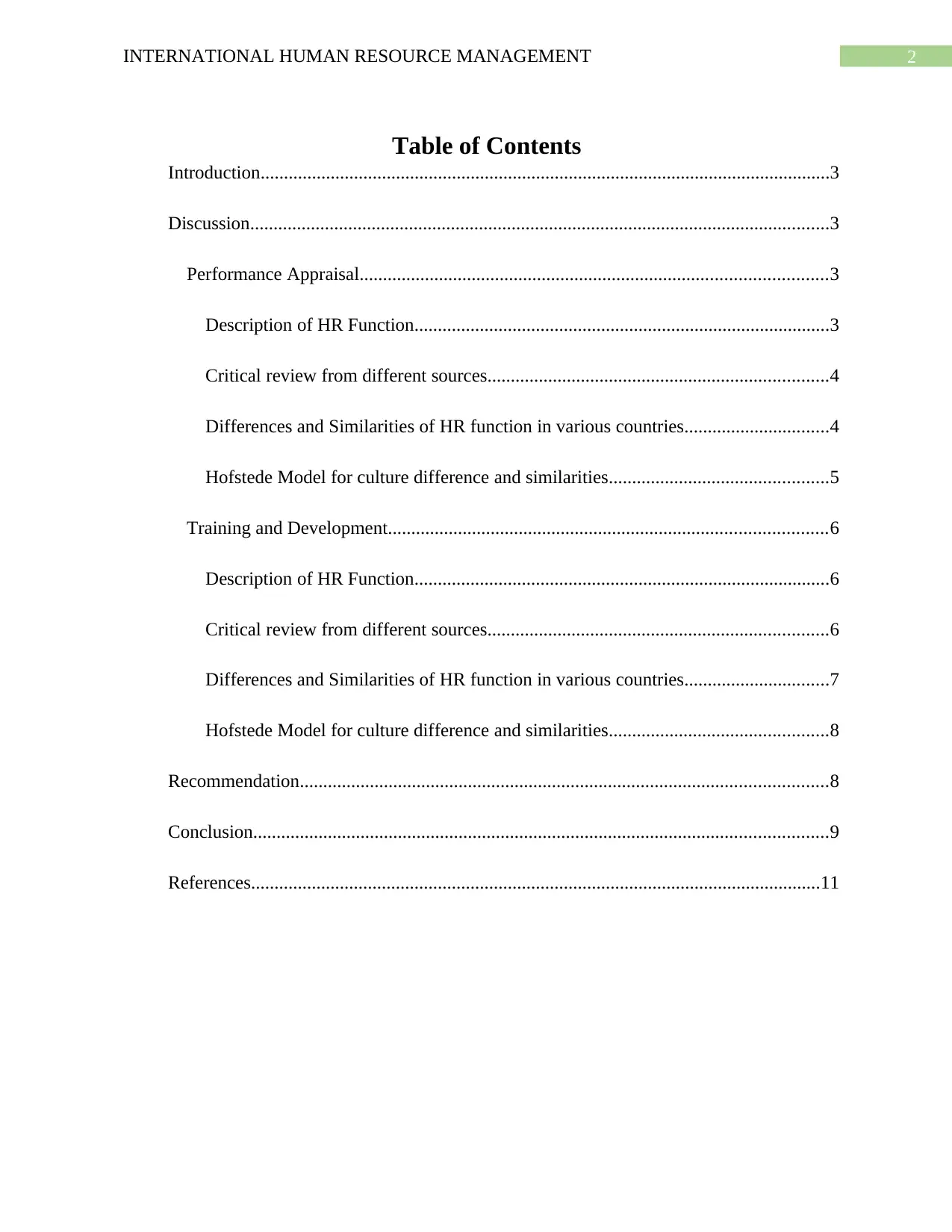
2INTERNATIONAL HUMAN RESOURCE MANAGEMENT
Table of Contents
Introduction..........................................................................................................................3
Discussion............................................................................................................................3
Performance Appraisal....................................................................................................3
Description of HR Function.........................................................................................3
Critical review from different sources.........................................................................4
Differences and Similarities of HR function in various countries...............................4
Hofstede Model for culture difference and similarities...............................................5
Training and Development..............................................................................................6
Description of HR Function.........................................................................................6
Critical review from different sources.........................................................................6
Differences and Similarities of HR function in various countries...............................7
Hofstede Model for culture difference and similarities...............................................8
Recommendation.................................................................................................................8
Conclusion...........................................................................................................................9
References..........................................................................................................................11
Table of Contents
Introduction..........................................................................................................................3
Discussion............................................................................................................................3
Performance Appraisal....................................................................................................3
Description of HR Function.........................................................................................3
Critical review from different sources.........................................................................4
Differences and Similarities of HR function in various countries...............................4
Hofstede Model for culture difference and similarities...............................................5
Training and Development..............................................................................................6
Description of HR Function.........................................................................................6
Critical review from different sources.........................................................................6
Differences and Similarities of HR function in various countries...............................7
Hofstede Model for culture difference and similarities...............................................8
Recommendation.................................................................................................................8
Conclusion...........................................................................................................................9
References..........................................................................................................................11
⊘ This is a preview!⊘
Do you want full access?
Subscribe today to unlock all pages.

Trusted by 1+ million students worldwide
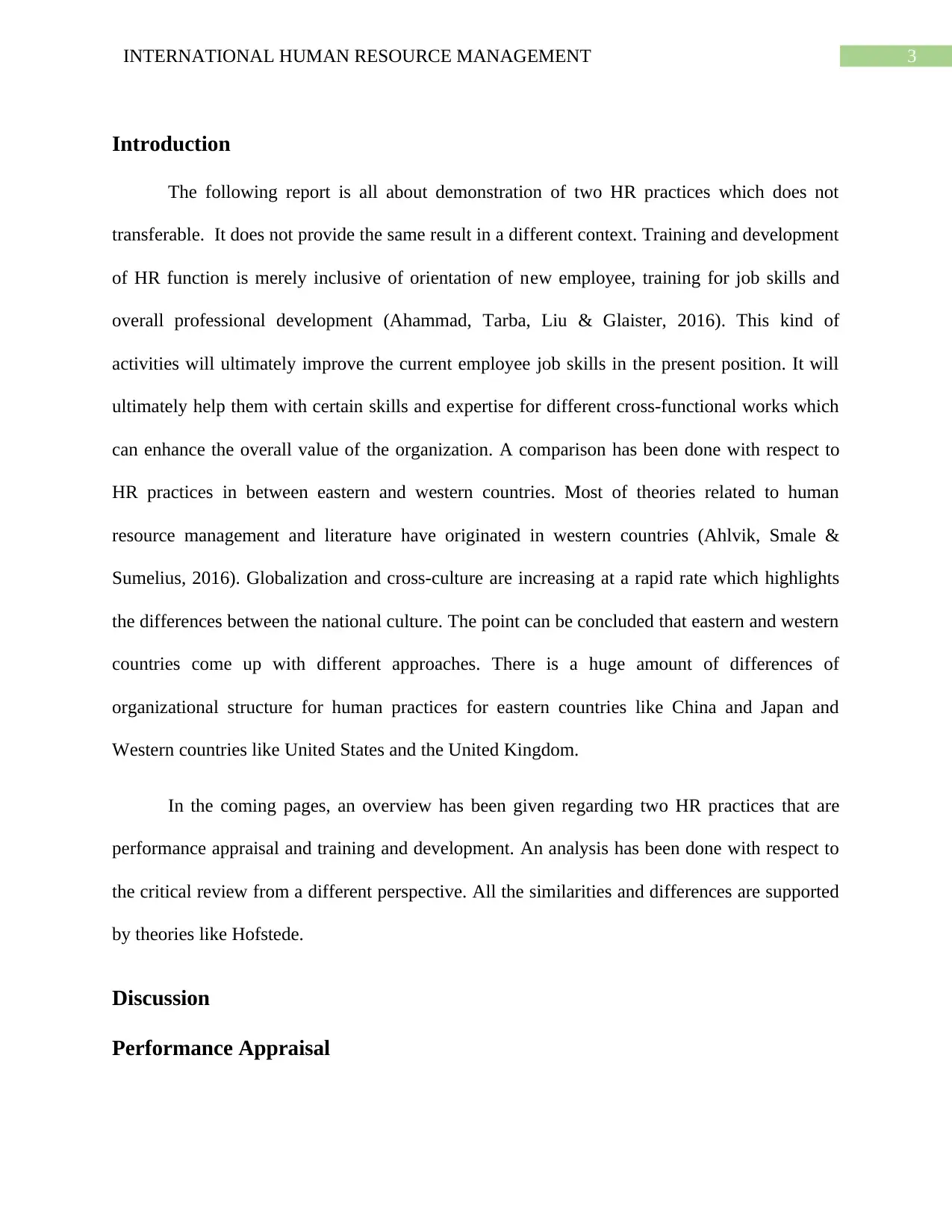
3INTERNATIONAL HUMAN RESOURCE MANAGEMENT
Introduction
The following report is all about demonstration of two HR practices which does not
transferable. It does not provide the same result in a different context. Training and development
of HR function is merely inclusive of orientation of new employee, training for job skills and
overall professional development (Ahammad, Tarba, Liu & Glaister, 2016). This kind of
activities will ultimately improve the current employee job skills in the present position. It will
ultimately help them with certain skills and expertise for different cross-functional works which
can enhance the overall value of the organization. A comparison has been done with respect to
HR practices in between eastern and western countries. Most of theories related to human
resource management and literature have originated in western countries (Ahlvik, Smale &
Sumelius, 2016). Globalization and cross-culture are increasing at a rapid rate which highlights
the differences between the national culture. The point can be concluded that eastern and western
countries come up with different approaches. There is a huge amount of differences of
organizational structure for human practices for eastern countries like China and Japan and
Western countries like United States and the United Kingdom.
In the coming pages, an overview has been given regarding two HR practices that are
performance appraisal and training and development. An analysis has been done with respect to
the critical review from a different perspective. All the similarities and differences are supported
by theories like Hofstede.
Discussion
Performance Appraisal
Introduction
The following report is all about demonstration of two HR practices which does not
transferable. It does not provide the same result in a different context. Training and development
of HR function is merely inclusive of orientation of new employee, training for job skills and
overall professional development (Ahammad, Tarba, Liu & Glaister, 2016). This kind of
activities will ultimately improve the current employee job skills in the present position. It will
ultimately help them with certain skills and expertise for different cross-functional works which
can enhance the overall value of the organization. A comparison has been done with respect to
HR practices in between eastern and western countries. Most of theories related to human
resource management and literature have originated in western countries (Ahlvik, Smale &
Sumelius, 2016). Globalization and cross-culture are increasing at a rapid rate which highlights
the differences between the national culture. The point can be concluded that eastern and western
countries come up with different approaches. There is a huge amount of differences of
organizational structure for human practices for eastern countries like China and Japan and
Western countries like United States and the United Kingdom.
In the coming pages, an overview has been given regarding two HR practices that are
performance appraisal and training and development. An analysis has been done with respect to
the critical review from a different perspective. All the similarities and differences are supported
by theories like Hofstede.
Discussion
Performance Appraisal
Paraphrase This Document
Need a fresh take? Get an instant paraphrase of this document with our AI Paraphraser
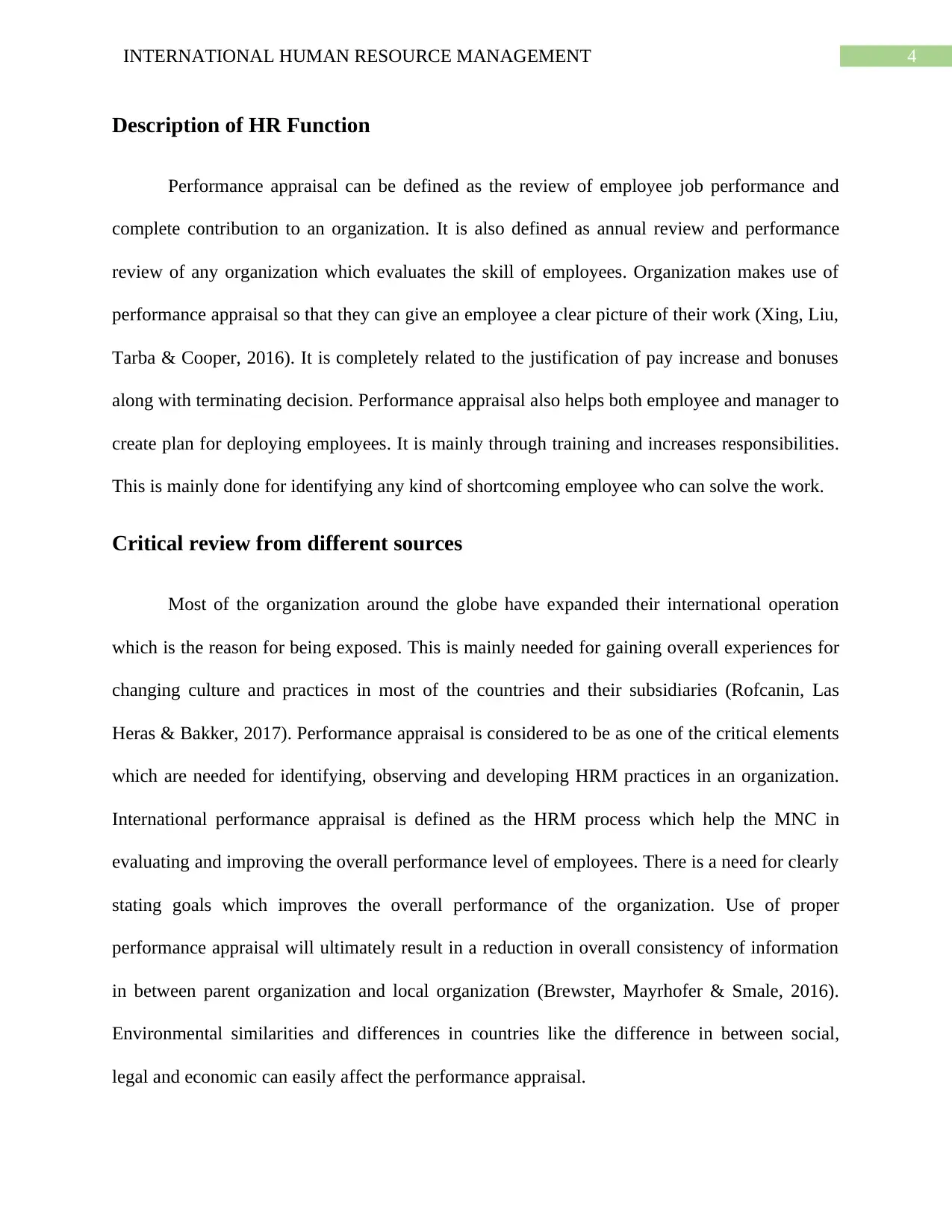
4INTERNATIONAL HUMAN RESOURCE MANAGEMENT
Description of HR Function
Performance appraisal can be defined as the review of employee job performance and
complete contribution to an organization. It is also defined as annual review and performance
review of any organization which evaluates the skill of employees. Organization makes use of
performance appraisal so that they can give an employee a clear picture of their work (Xing, Liu,
Tarba & Cooper, 2016). It is completely related to the justification of pay increase and bonuses
along with terminating decision. Performance appraisal also helps both employee and manager to
create plan for deploying employees. It is mainly through training and increases responsibilities.
This is mainly done for identifying any kind of shortcoming employee who can solve the work.
Critical review from different sources
Most of the organization around the globe have expanded their international operation
which is the reason for being exposed. This is mainly needed for gaining overall experiences for
changing culture and practices in most of the countries and their subsidiaries (Rofcanin, Las
Heras & Bakker, 2017). Performance appraisal is considered to be as one of the critical elements
which are needed for identifying, observing and developing HRM practices in an organization.
International performance appraisal is defined as the HRM process which help the MNC in
evaluating and improving the overall performance level of employees. There is a need for clearly
stating goals which improves the overall performance of the organization. Use of proper
performance appraisal will ultimately result in a reduction in overall consistency of information
in between parent organization and local organization (Brewster, Mayrhofer & Smale, 2016).
Environmental similarities and differences in countries like the difference in between social,
legal and economic can easily affect the performance appraisal.
Description of HR Function
Performance appraisal can be defined as the review of employee job performance and
complete contribution to an organization. It is also defined as annual review and performance
review of any organization which evaluates the skill of employees. Organization makes use of
performance appraisal so that they can give an employee a clear picture of their work (Xing, Liu,
Tarba & Cooper, 2016). It is completely related to the justification of pay increase and bonuses
along with terminating decision. Performance appraisal also helps both employee and manager to
create plan for deploying employees. It is mainly through training and increases responsibilities.
This is mainly done for identifying any kind of shortcoming employee who can solve the work.
Critical review from different sources
Most of the organization around the globe have expanded their international operation
which is the reason for being exposed. This is mainly needed for gaining overall experiences for
changing culture and practices in most of the countries and their subsidiaries (Rofcanin, Las
Heras & Bakker, 2017). Performance appraisal is considered to be as one of the critical elements
which are needed for identifying, observing and developing HRM practices in an organization.
International performance appraisal is defined as the HRM process which help the MNC in
evaluating and improving the overall performance level of employees. There is a need for clearly
stating goals which improves the overall performance of the organization. Use of proper
performance appraisal will ultimately result in a reduction in overall consistency of information
in between parent organization and local organization (Brewster, Mayrhofer & Smale, 2016).
Environmental similarities and differences in countries like the difference in between social,
legal and economic can easily affect the performance appraisal.
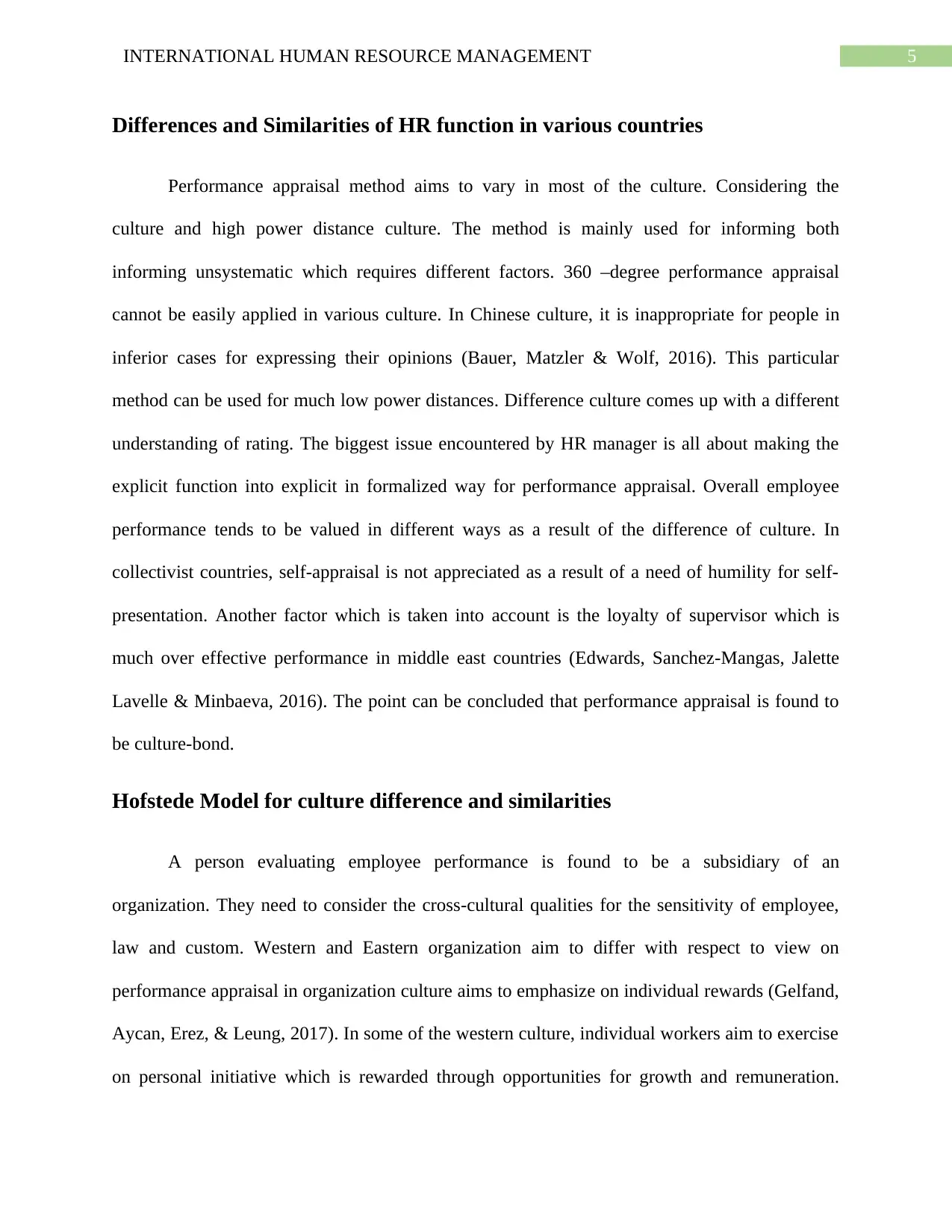
5INTERNATIONAL HUMAN RESOURCE MANAGEMENT
Differences and Similarities of HR function in various countries
Performance appraisal method aims to vary in most of the culture. Considering the
culture and high power distance culture. The method is mainly used for informing both
informing unsystematic which requires different factors. 360 –degree performance appraisal
cannot be easily applied in various culture. In Chinese culture, it is inappropriate for people in
inferior cases for expressing their opinions (Bauer, Matzler & Wolf, 2016). This particular
method can be used for much low power distances. Difference culture comes up with a different
understanding of rating. The biggest issue encountered by HR manager is all about making the
explicit function into explicit in formalized way for performance appraisal. Overall employee
performance tends to be valued in different ways as a result of the difference of culture. In
collectivist countries, self-appraisal is not appreciated as a result of a need of humility for self-
presentation. Another factor which is taken into account is the loyalty of supervisor which is
much over effective performance in middle east countries (Edwards, Sanchez-Mangas, Jalette
Lavelle & Minbaeva, 2016). The point can be concluded that performance appraisal is found to
be culture-bond.
Hofstede Model for culture difference and similarities
A person evaluating employee performance is found to be a subsidiary of an
organization. They need to consider the cross-cultural qualities for the sensitivity of employee,
law and custom. Western and Eastern organization aim to differ with respect to view on
performance appraisal in organization culture aims to emphasize on individual rewards (Gelfand,
Aycan, Erez, & Leung, 2017). In some of the western culture, individual workers aim to exercise
on personal initiative which is rewarded through opportunities for growth and remuneration.
Differences and Similarities of HR function in various countries
Performance appraisal method aims to vary in most of the culture. Considering the
culture and high power distance culture. The method is mainly used for informing both
informing unsystematic which requires different factors. 360 –degree performance appraisal
cannot be easily applied in various culture. In Chinese culture, it is inappropriate for people in
inferior cases for expressing their opinions (Bauer, Matzler & Wolf, 2016). This particular
method can be used for much low power distances. Difference culture comes up with a different
understanding of rating. The biggest issue encountered by HR manager is all about making the
explicit function into explicit in formalized way for performance appraisal. Overall employee
performance tends to be valued in different ways as a result of the difference of culture. In
collectivist countries, self-appraisal is not appreciated as a result of a need of humility for self-
presentation. Another factor which is taken into account is the loyalty of supervisor which is
much over effective performance in middle east countries (Edwards, Sanchez-Mangas, Jalette
Lavelle & Minbaeva, 2016). The point can be concluded that performance appraisal is found to
be culture-bond.
Hofstede Model for culture difference and similarities
A person evaluating employee performance is found to be a subsidiary of an
organization. They need to consider the cross-cultural qualities for the sensitivity of employee,
law and custom. Western and Eastern organization aim to differ with respect to view on
performance appraisal in organization culture aims to emphasize on individual rewards (Gelfand,
Aycan, Erez, & Leung, 2017). In some of the western culture, individual workers aim to exercise
on personal initiative which is rewarded through opportunities for growth and remuneration.
⊘ This is a preview!⊘
Do you want full access?
Subscribe today to unlock all pages.

Trusted by 1+ million students worldwide
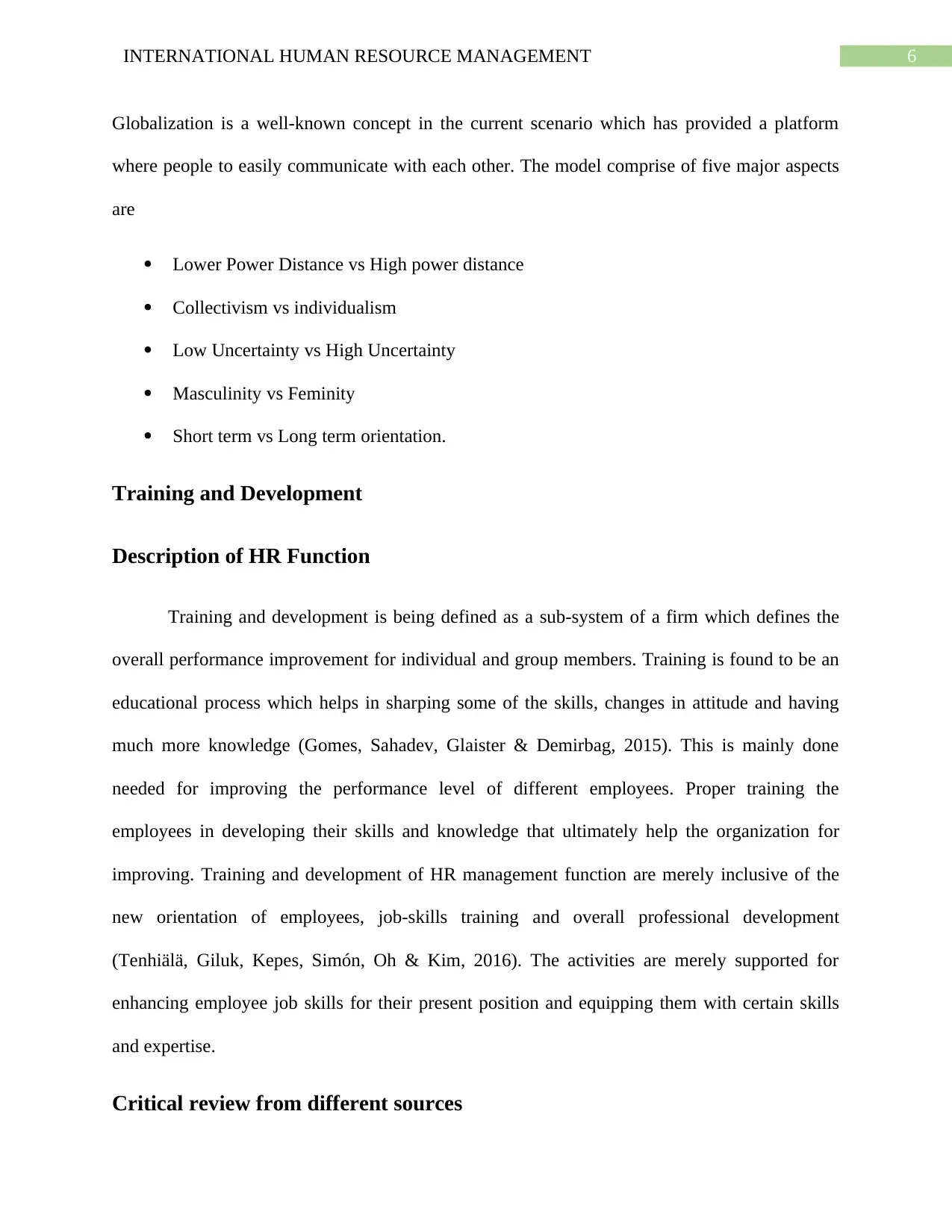
6INTERNATIONAL HUMAN RESOURCE MANAGEMENT
Globalization is a well-known concept in the current scenario which has provided a platform
where people to easily communicate with each other. The model comprise of five major aspects
are
Lower Power Distance vs High power distance
Collectivism vs individualism
Low Uncertainty vs High Uncertainty
Masculinity vs Feminity
Short term vs Long term orientation.
Training and Development
Description of HR Function
Training and development is being defined as a sub-system of a firm which defines the
overall performance improvement for individual and group members. Training is found to be an
educational process which helps in sharping some of the skills, changes in attitude and having
much more knowledge (Gomes, Sahadev, Glaister & Demirbag, 2015). This is mainly done
needed for improving the performance level of different employees. Proper training the
employees in developing their skills and knowledge that ultimately help the organization for
improving. Training and development of HR management function are merely inclusive of the
new orientation of employees, job-skills training and overall professional development
(Tenhiälä, Giluk, Kepes, Simón, Oh & Kim, 2016). The activities are merely supported for
enhancing employee job skills for their present position and equipping them with certain skills
and expertise.
Critical review from different sources
Globalization is a well-known concept in the current scenario which has provided a platform
where people to easily communicate with each other. The model comprise of five major aspects
are
Lower Power Distance vs High power distance
Collectivism vs individualism
Low Uncertainty vs High Uncertainty
Masculinity vs Feminity
Short term vs Long term orientation.
Training and Development
Description of HR Function
Training and development is being defined as a sub-system of a firm which defines the
overall performance improvement for individual and group members. Training is found to be an
educational process which helps in sharping some of the skills, changes in attitude and having
much more knowledge (Gomes, Sahadev, Glaister & Demirbag, 2015). This is mainly done
needed for improving the performance level of different employees. Proper training the
employees in developing their skills and knowledge that ultimately help the organization for
improving. Training and development of HR management function are merely inclusive of the
new orientation of employees, job-skills training and overall professional development
(Tenhiälä, Giluk, Kepes, Simón, Oh & Kim, 2016). The activities are merely supported for
enhancing employee job skills for their present position and equipping them with certain skills
and expertise.
Critical review from different sources
Paraphrase This Document
Need a fresh take? Get an instant paraphrase of this document with our AI Paraphraser
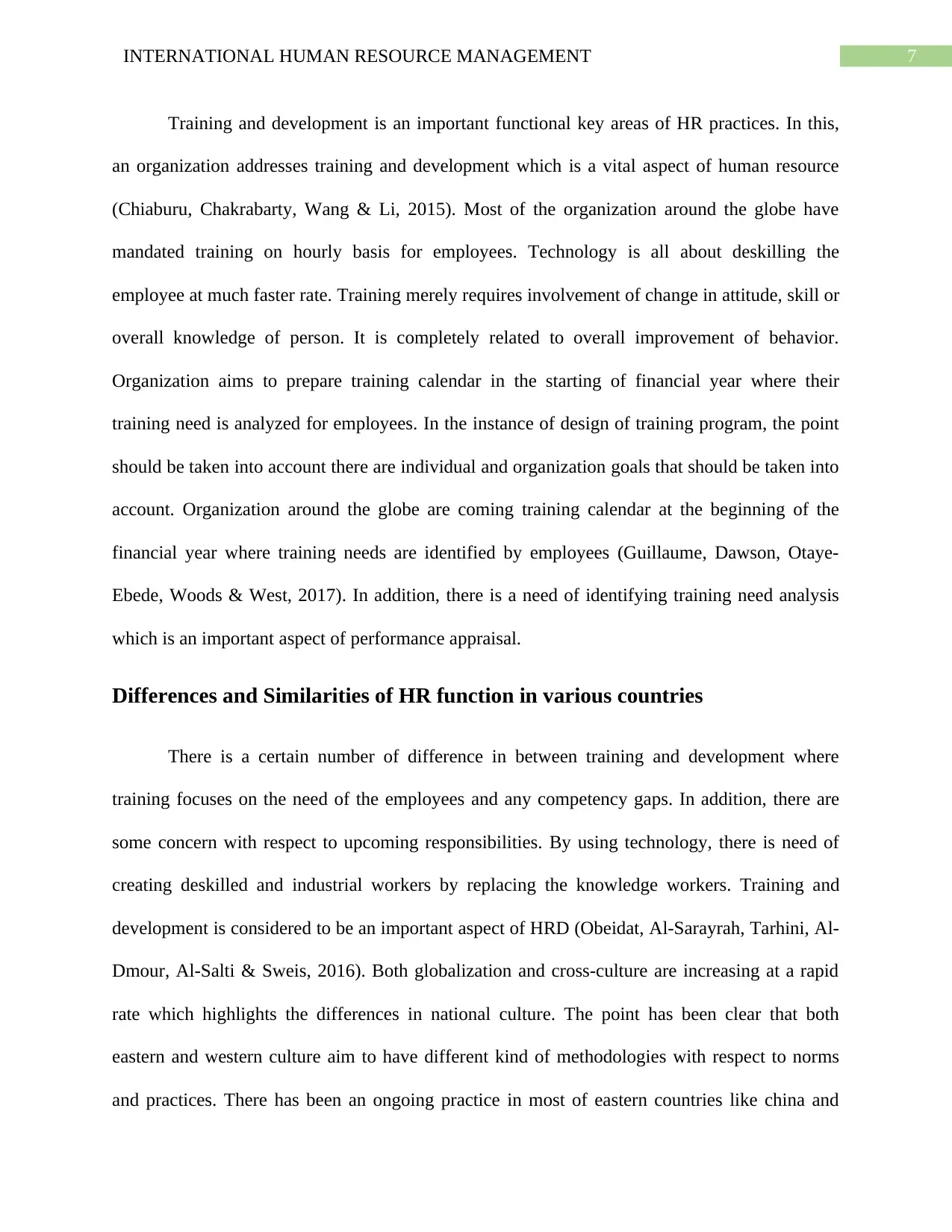
7INTERNATIONAL HUMAN RESOURCE MANAGEMENT
Training and development is an important functional key areas of HR practices. In this,
an organization addresses training and development which is a vital aspect of human resource
(Chiaburu, Chakrabarty, Wang & Li, 2015). Most of the organization around the globe have
mandated training on hourly basis for employees. Technology is all about deskilling the
employee at much faster rate. Training merely requires involvement of change in attitude, skill or
overall knowledge of person. It is completely related to overall improvement of behavior.
Organization aims to prepare training calendar in the starting of financial year where their
training need is analyzed for employees. In the instance of design of training program, the point
should be taken into account there are individual and organization goals that should be taken into
account. Organization around the globe are coming training calendar at the beginning of the
financial year where training needs are identified by employees (Guillaume, Dawson, Otaye‐
Ebede, Woods & West, 2017). In addition, there is a need of identifying training need analysis
which is an important aspect of performance appraisal.
Differences and Similarities of HR function in various countries
There is a certain number of difference in between training and development where
training focuses on the need of the employees and any competency gaps. In addition, there are
some concern with respect to upcoming responsibilities. By using technology, there is need of
creating deskilled and industrial workers by replacing the knowledge workers. Training and
development is considered to be an important aspect of HRD (Obeidat, Al-Sarayrah, Tarhini, Al-
Dmour, Al-Salti & Sweis, 2016). Both globalization and cross-culture are increasing at a rapid
rate which highlights the differences in national culture. The point has been clear that both
eastern and western culture aim to have different kind of methodologies with respect to norms
and practices. There has been an ongoing practice in most of eastern countries like china and
Training and development is an important functional key areas of HR practices. In this,
an organization addresses training and development which is a vital aspect of human resource
(Chiaburu, Chakrabarty, Wang & Li, 2015). Most of the organization around the globe have
mandated training on hourly basis for employees. Technology is all about deskilling the
employee at much faster rate. Training merely requires involvement of change in attitude, skill or
overall knowledge of person. It is completely related to overall improvement of behavior.
Organization aims to prepare training calendar in the starting of financial year where their
training need is analyzed for employees. In the instance of design of training program, the point
should be taken into account there are individual and organization goals that should be taken into
account. Organization around the globe are coming training calendar at the beginning of the
financial year where training needs are identified by employees (Guillaume, Dawson, Otaye‐
Ebede, Woods & West, 2017). In addition, there is a need of identifying training need analysis
which is an important aspect of performance appraisal.
Differences and Similarities of HR function in various countries
There is a certain number of difference in between training and development where
training focuses on the need of the employees and any competency gaps. In addition, there are
some concern with respect to upcoming responsibilities. By using technology, there is need of
creating deskilled and industrial workers by replacing the knowledge workers. Training and
development is considered to be an important aspect of HRD (Obeidat, Al-Sarayrah, Tarhini, Al-
Dmour, Al-Salti & Sweis, 2016). Both globalization and cross-culture are increasing at a rapid
rate which highlights the differences in national culture. The point has been clear that both
eastern and western culture aim to have different kind of methodologies with respect to norms
and practices. There has been an ongoing practice in most of eastern countries like china and

8INTERNATIONAL HUMAN RESOURCE MANAGEMENT
Japan and western countries like United States and United Kingdom (Guillaume, Dawson,
Otaye‐Ebede, Woods & West, 2017). It merely tends to differ with respect to organizational
structure, communication and motivation programs and resolution of any kind of conflict.
Hofstede Model for culture difference and similarities
Human resource leaders come up with a dual role for focusing on both things that are
process and person. Most of the eastern countries value aim to value the person over the process.
Business based on this aim to nurture the employee with certain HR policies where they can
make cultural advantage that will help in HR management (Tatoglu, Glaister & Demirbag,
2016). There are certain number of issues like loyalty, hospitality and long term employee
relationship which is needed for training and development. Hofstede has come up with one of the
important studies which value the influence of work culture. He defined how collective
programming is needed for distinguishing different members of a group of people from other one
(Bird & Mendenhall, 2016). Hofstede model for national culture comprises of six dimensions
which comprises of aspects like power distance index, individual vs collectivism, masculinity vs
femininity, uncertain avoidance, long term orientation vs short term orientation.
Recommendation
Most of the organization around the globe are completely powered by its people. There is
need for some effective HR strategy which is needed for ensuring overall productivity along with
maximizing success. HR professional play a major role in coming up the right strategy for
providing support to organizational direction. This comes up with the ability to have vision
beyond the tactics for addressing areas of high-level focus which will drive success.
Japan and western countries like United States and United Kingdom (Guillaume, Dawson,
Otaye‐Ebede, Woods & West, 2017). It merely tends to differ with respect to organizational
structure, communication and motivation programs and resolution of any kind of conflict.
Hofstede Model for culture difference and similarities
Human resource leaders come up with a dual role for focusing on both things that are
process and person. Most of the eastern countries value aim to value the person over the process.
Business based on this aim to nurture the employee with certain HR policies where they can
make cultural advantage that will help in HR management (Tatoglu, Glaister & Demirbag,
2016). There are certain number of issues like loyalty, hospitality and long term employee
relationship which is needed for training and development. Hofstede has come up with one of the
important studies which value the influence of work culture. He defined how collective
programming is needed for distinguishing different members of a group of people from other one
(Bird & Mendenhall, 2016). Hofstede model for national culture comprises of six dimensions
which comprises of aspects like power distance index, individual vs collectivism, masculinity vs
femininity, uncertain avoidance, long term orientation vs short term orientation.
Recommendation
Most of the organization around the globe are completely powered by its people. There is
need for some effective HR strategy which is needed for ensuring overall productivity along with
maximizing success. HR professional play a major role in coming up the right strategy for
providing support to organizational direction. This comes up with the ability to have vision
beyond the tactics for addressing areas of high-level focus which will drive success.
⊘ This is a preview!⊘
Do you want full access?
Subscribe today to unlock all pages.

Trusted by 1+ million students worldwide
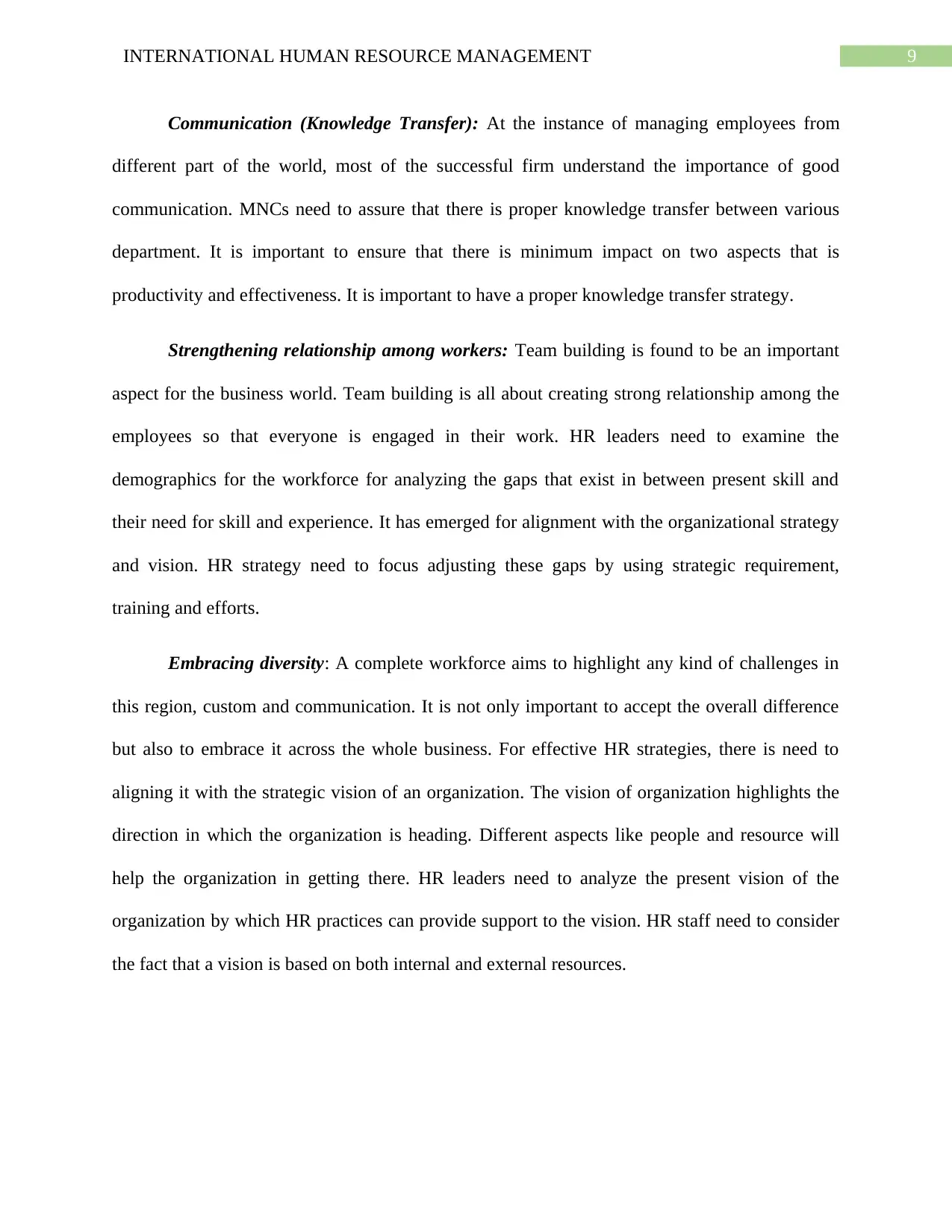
9INTERNATIONAL HUMAN RESOURCE MANAGEMENT
Communication (Knowledge Transfer): At the instance of managing employees from
different part of the world, most of the successful firm understand the importance of good
communication. MNCs need to assure that there is proper knowledge transfer between various
department. It is important to ensure that there is minimum impact on two aspects that is
productivity and effectiveness. It is important to have a proper knowledge transfer strategy.
Strengthening relationship among workers: Team building is found to be an important
aspect for the business world. Team building is all about creating strong relationship among the
employees so that everyone is engaged in their work. HR leaders need to examine the
demographics for the workforce for analyzing the gaps that exist in between present skill and
their need for skill and experience. It has emerged for alignment with the organizational strategy
and vision. HR strategy need to focus adjusting these gaps by using strategic requirement,
training and efforts.
Embracing diversity: A complete workforce aims to highlight any kind of challenges in
this region, custom and communication. It is not only important to accept the overall difference
but also to embrace it across the whole business. For effective HR strategies, there is need to
aligning it with the strategic vision of an organization. The vision of organization highlights the
direction in which the organization is heading. Different aspects like people and resource will
help the organization in getting there. HR leaders need to analyze the present vision of the
organization by which HR practices can provide support to the vision. HR staff need to consider
the fact that a vision is based on both internal and external resources.
Communication (Knowledge Transfer): At the instance of managing employees from
different part of the world, most of the successful firm understand the importance of good
communication. MNCs need to assure that there is proper knowledge transfer between various
department. It is important to ensure that there is minimum impact on two aspects that is
productivity and effectiveness. It is important to have a proper knowledge transfer strategy.
Strengthening relationship among workers: Team building is found to be an important
aspect for the business world. Team building is all about creating strong relationship among the
employees so that everyone is engaged in their work. HR leaders need to examine the
demographics for the workforce for analyzing the gaps that exist in between present skill and
their need for skill and experience. It has emerged for alignment with the organizational strategy
and vision. HR strategy need to focus adjusting these gaps by using strategic requirement,
training and efforts.
Embracing diversity: A complete workforce aims to highlight any kind of challenges in
this region, custom and communication. It is not only important to accept the overall difference
but also to embrace it across the whole business. For effective HR strategies, there is need to
aligning it with the strategic vision of an organization. The vision of organization highlights the
direction in which the organization is heading. Different aspects like people and resource will
help the organization in getting there. HR leaders need to analyze the present vision of the
organization by which HR practices can provide support to the vision. HR staff need to consider
the fact that a vision is based on both internal and external resources.
Paraphrase This Document
Need a fresh take? Get an instant paraphrase of this document with our AI Paraphraser
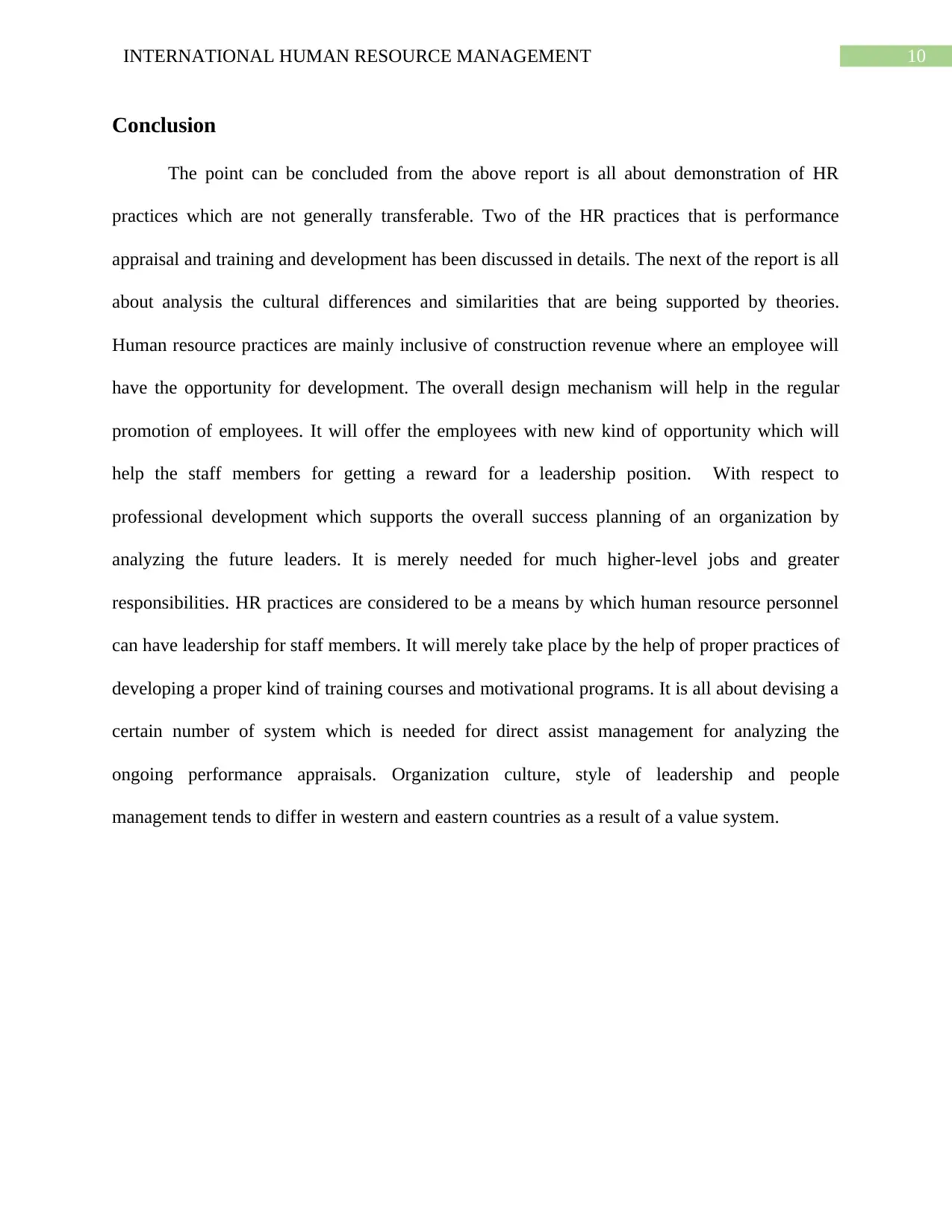
10INTERNATIONAL HUMAN RESOURCE MANAGEMENT
Conclusion
The point can be concluded from the above report is all about demonstration of HR
practices which are not generally transferable. Two of the HR practices that is performance
appraisal and training and development has been discussed in details. The next of the report is all
about analysis the cultural differences and similarities that are being supported by theories.
Human resource practices are mainly inclusive of construction revenue where an employee will
have the opportunity for development. The overall design mechanism will help in the regular
promotion of employees. It will offer the employees with new kind of opportunity which will
help the staff members for getting a reward for a leadership position. With respect to
professional development which supports the overall success planning of an organization by
analyzing the future leaders. It is merely needed for much higher-level jobs and greater
responsibilities. HR practices are considered to be a means by which human resource personnel
can have leadership for staff members. It will merely take place by the help of proper practices of
developing a proper kind of training courses and motivational programs. It is all about devising a
certain number of system which is needed for direct assist management for analyzing the
ongoing performance appraisals. Organization culture, style of leadership and people
management tends to differ in western and eastern countries as a result of a value system.
Conclusion
The point can be concluded from the above report is all about demonstration of HR
practices which are not generally transferable. Two of the HR practices that is performance
appraisal and training and development has been discussed in details. The next of the report is all
about analysis the cultural differences and similarities that are being supported by theories.
Human resource practices are mainly inclusive of construction revenue where an employee will
have the opportunity for development. The overall design mechanism will help in the regular
promotion of employees. It will offer the employees with new kind of opportunity which will
help the staff members for getting a reward for a leadership position. With respect to
professional development which supports the overall success planning of an organization by
analyzing the future leaders. It is merely needed for much higher-level jobs and greater
responsibilities. HR practices are considered to be a means by which human resource personnel
can have leadership for staff members. It will merely take place by the help of proper practices of
developing a proper kind of training courses and motivational programs. It is all about devising a
certain number of system which is needed for direct assist management for analyzing the
ongoing performance appraisals. Organization culture, style of leadership and people
management tends to differ in western and eastern countries as a result of a value system.
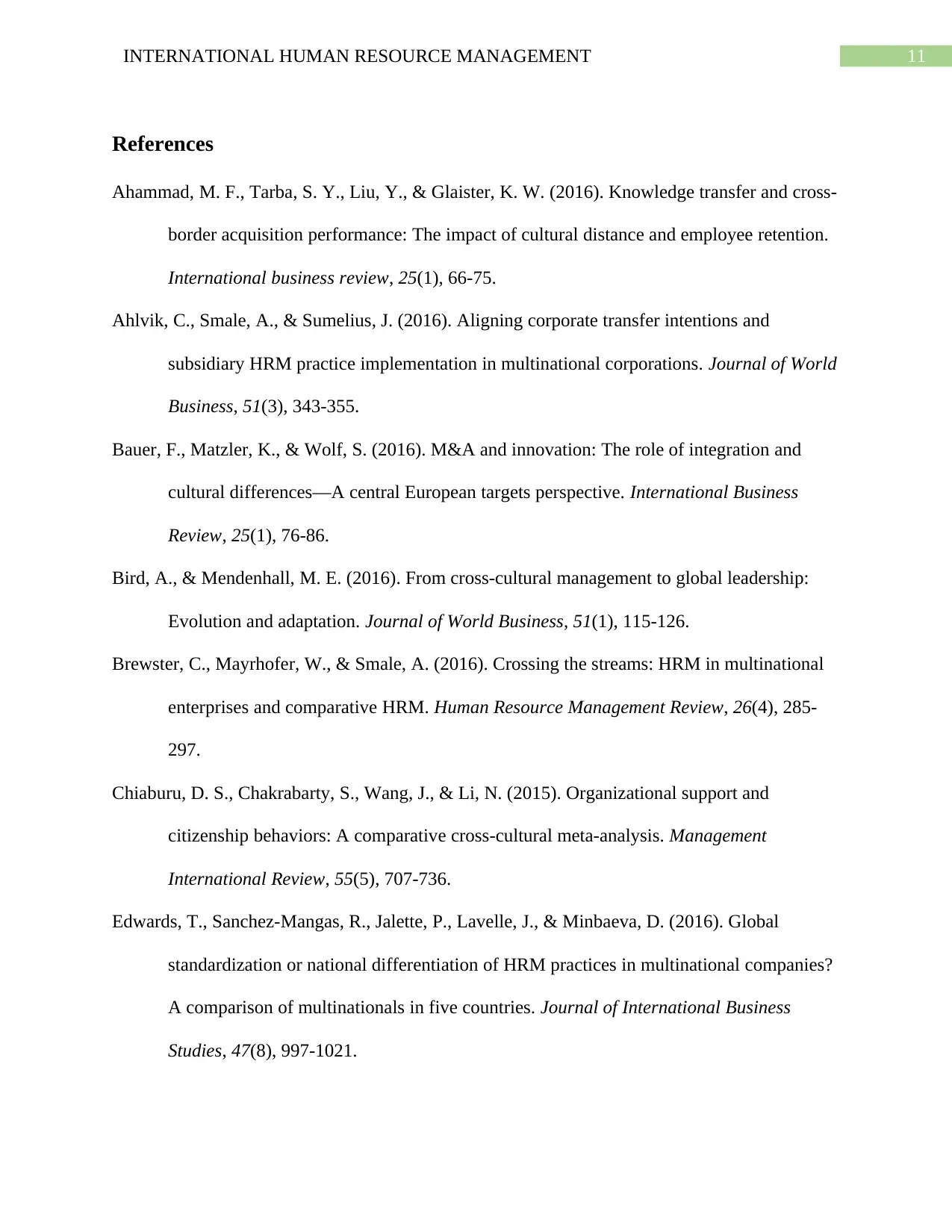
11INTERNATIONAL HUMAN RESOURCE MANAGEMENT
References
Ahammad, M. F., Tarba, S. Y., Liu, Y., & Glaister, K. W. (2016). Knowledge transfer and cross-
border acquisition performance: The impact of cultural distance and employee retention.
International business review, 25(1), 66-75.
Ahlvik, C., Smale, A., & Sumelius, J. (2016). Aligning corporate transfer intentions and
subsidiary HRM practice implementation in multinational corporations. Journal of World
Business, 51(3), 343-355.
Bauer, F., Matzler, K., & Wolf, S. (2016). M&A and innovation: The role of integration and
cultural differences—A central European targets perspective. International Business
Review, 25(1), 76-86.
Bird, A., & Mendenhall, M. E. (2016). From cross-cultural management to global leadership:
Evolution and adaptation. Journal of World Business, 51(1), 115-126.
Brewster, C., Mayrhofer, W., & Smale, A. (2016). Crossing the streams: HRM in multinational
enterprises and comparative HRM. Human Resource Management Review, 26(4), 285-
297.
Chiaburu, D. S., Chakrabarty, S., Wang, J., & Li, N. (2015). Organizational support and
citizenship behaviors: A comparative cross-cultural meta-analysis. Management
International Review, 55(5), 707-736.
Edwards, T., Sanchez-Mangas, R., Jalette, P., Lavelle, J., & Minbaeva, D. (2016). Global
standardization or national differentiation of HRM practices in multinational companies?
A comparison of multinationals in five countries. Journal of International Business
Studies, 47(8), 997-1021.
References
Ahammad, M. F., Tarba, S. Y., Liu, Y., & Glaister, K. W. (2016). Knowledge transfer and cross-
border acquisition performance: The impact of cultural distance and employee retention.
International business review, 25(1), 66-75.
Ahlvik, C., Smale, A., & Sumelius, J. (2016). Aligning corporate transfer intentions and
subsidiary HRM practice implementation in multinational corporations. Journal of World
Business, 51(3), 343-355.
Bauer, F., Matzler, K., & Wolf, S. (2016). M&A and innovation: The role of integration and
cultural differences—A central European targets perspective. International Business
Review, 25(1), 76-86.
Bird, A., & Mendenhall, M. E. (2016). From cross-cultural management to global leadership:
Evolution and adaptation. Journal of World Business, 51(1), 115-126.
Brewster, C., Mayrhofer, W., & Smale, A. (2016). Crossing the streams: HRM in multinational
enterprises and comparative HRM. Human Resource Management Review, 26(4), 285-
297.
Chiaburu, D. S., Chakrabarty, S., Wang, J., & Li, N. (2015). Organizational support and
citizenship behaviors: A comparative cross-cultural meta-analysis. Management
International Review, 55(5), 707-736.
Edwards, T., Sanchez-Mangas, R., Jalette, P., Lavelle, J., & Minbaeva, D. (2016). Global
standardization or national differentiation of HRM practices in multinational companies?
A comparison of multinationals in five countries. Journal of International Business
Studies, 47(8), 997-1021.
⊘ This is a preview!⊘
Do you want full access?
Subscribe today to unlock all pages.

Trusted by 1+ million students worldwide
1 out of 14
Related Documents
Your All-in-One AI-Powered Toolkit for Academic Success.
+13062052269
info@desklib.com
Available 24*7 on WhatsApp / Email
![[object Object]](/_next/static/media/star-bottom.7253800d.svg)
Unlock your academic potential
Copyright © 2020–2025 A2Z Services. All Rights Reserved. Developed and managed by ZUCOL.





